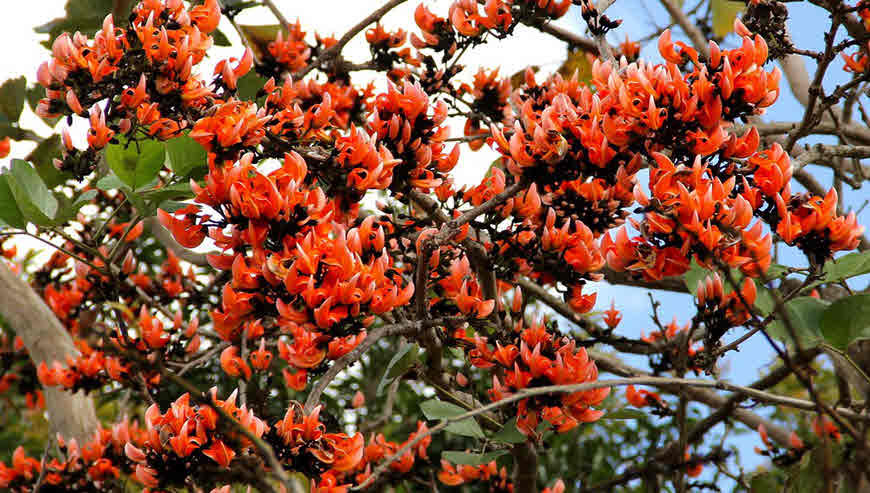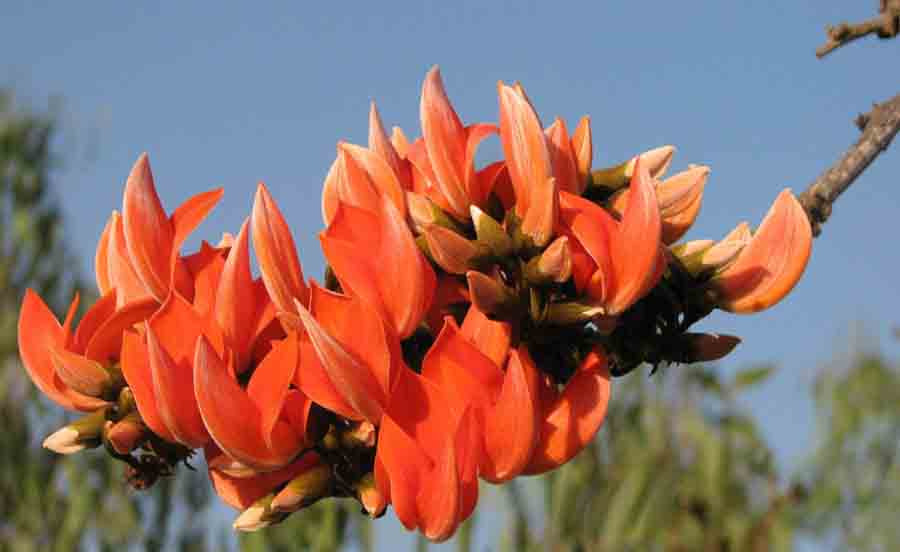Dhak(Palash)
| Botanical Name: | Butea monosperma |
|---|---|
| English Name: | Flame of the Forest |
| Local Name: | Local name:-Flame of the Forest, bastard teak, battle of Plassey tree, Bengal kino, palas tree, parrot tree • Assamese: bipornok, kingxuk, polax • Bengali: palash • Gujarati: kesudo, khakhro, palash • Hindi: dhak, palash, tesu • Kannada: |
More Information
Unique identification feature
- Native to India, Flame of the Forest is a medium sized tree, growing from 20 to 4O feet high, and the trunk is usually crooked and twisted with irregular branches and rough, grey bark.The leaves are pinnate, with an 8-16 cm petiole and three leaflets, each leaflet 10-20 cm long. The hindi phrase ("Dhaak ke teen paat") comes from the prominent three leaflets of this tree.<!--[if !supportLists]-->·It is seen in all its ugliness in December and January when most of the leaves fall: but from January to March it truly becomes a tree of flame, a riot of orange and vermilion flowers covering the entire crown. <!--[endif]-->These flowers, which are scentless, are massed along the ends of the stalks--dark velvety green like the cup-shaped calices--and the brilliance of the stiff, bright flowers is shown off to perfection by this deep, contrasting colourEach flower consists of five petals comprising one standard, two smaller wings and a very curved beak-shaped keel. It is this keel which gives it the name of Parrot Tree. In olden days, the flowers of Tesu were used to make color for the festival of HoliIn Manipur, there is an interesting cultural use of the wood of this tree with beautiful flowers - when a member of the Meitei community dies and, for some reasons, his body cannot be be found, the wood of this tree is cremated in place of the body.A postal stamp was issued by the Indian Postal Department to commemorate this flower.
Unique identification feature
- Medicinal use:- Butea gum, or Bengal kino, an exudate from the tannin-rich vesicles in the bark, is used medicinally A powerful astringent, it is used in the treatment of diarrhoea and wounds The seeds, ground into a paste with honey, are used for their anthelmintic, antifungal, antibacterial and purgative properties.The seed paste, mixed with lemon juice, are used as a rubefacient.The seeds contain around 18% oil. Called 'moodoga oil', it is an effective treatment for hookworms. The flowers and leaves are aphrodisiac, astringent and diuretic. The flowers are useful in the treatment of liver disordersThe flowers contain butrin and isobutrin. These compounds have been shown to have antihepatotoxic principles.A potential anti-asthmatic agent has been reported from the bark<!--[if !supportLists]-->· The flowers are used for the preparation of a yellow dye (for silk especially, also ritually use) <!--[if !supportLists]-->· <!--[endif]-->A bright yellow to deep orange-red dye, known as butein, can be prepared from the flowers. It is used especially for dyeing silk and sometimes for cotton, and is traditionally used by Hindus to mark the forehead. <!--[if !supportLists]-->· <!--[endif]-->A red dye is obtained from the roots
Planting and Care
- Seed - sow in situ Germination, which starts in about 10 - 12 days, is completed in 4 weeks Fresh seeds have a good germinative capacity (about 63%) at optimum germination temperature of about 30°c While germinating in the wild, the seed remains in the pod which opens at the tip and allows the young shoot and root to emerge The cotyledons remain attached to the seedling for a considerable time.After a good rain, find a spot that is the first to dry out. Water trapped beneath the scales may rot the bulb, so a well-drained site is essential. Also, select a site that gets full sun. For dependable blooms, lilies need six to eight hours of direct sunlight a day.Sunlight: Full sun to part shade,Soil: well-drained soil,Water: Medium,Temperature: 30° C,Fertilizer: Apply any organic fertilizeCaring for Palash: -The mulch should feel moist but not wet., Apply a high-potassium liquid fertilizer every 2 weeks from early spring until 6 weeks after flowering.,Keep moist in winter.





